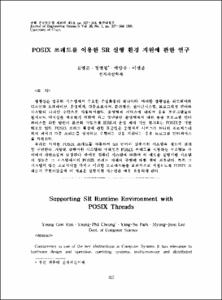Ku-band 위성방송수신용 고안정 DRO에 관한 연구
- Alternative Title
- A study on the highly stable Dielectric Resonator Oscillator for a Ku-band Satellite Broadcasting Systems
- Abstract
- 본 연구에서는 Ku-band 위성방송 수신장치를 위하여 유전체 공진기를 이용한 GaAs MESFET 고안정 발진기 DRO를 설계하여 구현하였다. ??전체 공진기와 마이크로스트립 선로 사이의 결합계수 β가 공진기의 Qex 값에 미치는 관계식을 해석적으로 유도하였다. 발진기의 결합감도 ( ?? )를 0.5이하로 유지시키기 위해 유전체 공진기와 기판 사이에 Spacer를 삽입한 발진기를 제작하여 Spacer가 없는 경우와의 반사계수 특성을 비교하였다.
이 발진기의 최대출력은 5dBm이였고, 0∼100℃ 온도변화 범위 내에서 발진주파수의 편차는 10.678 GHz ±100KHz (p-p)이었다. Spacer를 삽입한 결과 발진기의 주파수 온도 안정성이 2배정도 개선되었다.
In this study, a highly stable GaAs MESFET oscillator using the dielectic resonator for Ku-band satellite broadcasting systems was designed and implemented. The relationship equation between the coupling coefficient βand the Qex value by couping the dielectric resonator and the microstrip line was obtained analytically.
In order to keep the coupling sensitivity ( ?? ) of the oscillator less than 0.5, a spacer was interposed between the dielectric resonator and the substrate, the characteristics of the reflection coefficient of the oscillator with the spacer was compared with those of the oscillator without the spacer.
The maximum outut power of the oscillator was 5 dBm, and the frequency drift, which shows the frequency temperature stability, was 10.678GHz ±100KHz (p-p) within the range of the temperature variation of 0∼100℃. The frequency temperature stability of the oscillator was doubled as a result of the interposition of the spacer.
In this study, a highly stable GaAs MESFET oscillator using the dielectic resonator for Ku-band satellite broadcasting systems was designed and implemented. The relationship equation between the coupling coefficient βand the Qex value by couping the dielectric resonator and the microstrip line was obtained analytically.
In order to keep the coupling sensitivity ( ?? ) of the oscillator less than 0.5, a spacer was interposed between the dielectric resonator and the substrate, the characteristics of the reflection coefficient of the oscillator with the spacer was compared with those of the oscillator without the spacer.
The maximum outut power of the oscillator was 5 dBm, and the frequency drift, which shows the frequency temperature stability, was 10.678GHz ±100KHz (p-p) within the range of the temperature variation of 0∼100℃. The frequency temperature stability of the oscillator was doubled as a result of the interposition of the spacer.
- Issued Date
- 1994
- Type
- Research Laboratory
- Alternative Author(s)
- Jung, Chun-Suk
- Publisher
- 공학연구논문집
- Language
- kor
- Rights
- 울산대학교 저작물은 저작권에 의해 보호받습니다.
- Citation Volume
- 25
- Citation Number
- 2
- Citation Start Page
- 165
- Citation End Page
- 180
- Appears in Collections:
- Research Laboratory > Engineering Research
- 파일 목록
-
-
Download
 000002025504.pdf
기타 데이터 / 1.1 MB / Adobe PDF
000002025504.pdf
기타 데이터 / 1.1 MB / Adobe PDF
-
Items in Repository are protected by copyright, with all rights reserved, unless otherwise indicated.